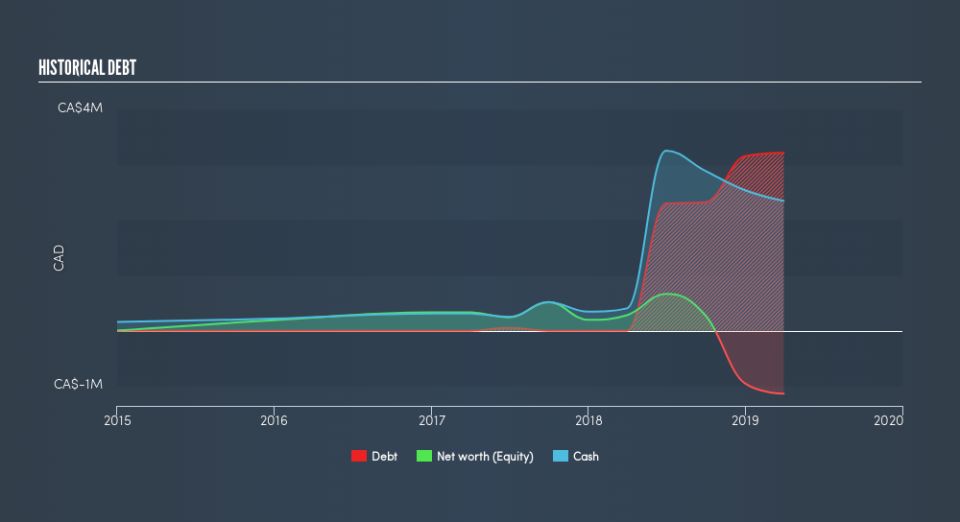Here's Why Katipult Technology (CVE:FUND) Might Be Better Off Without Debt

Legendary fund manager Li Lu (who Charlie Munger backed) once said, 'The biggest investment risk is not the volatility of prices, but whether you will suffer a permanent loss of capital.' When we think about how risky a company is, we always like to look at its use of debt, since debt overload can lead to ruin. We can see that Katipult Technology Corp. (CVE:FUND) does use debt in its business. But should shareholders be worried about its use of debt?
What Risk Does Debt Bring?
Debt and other liabilities become risky for a business when it cannot easily fulfill those obligations, either with free cash flow or by raising capital at an attractive price. In the worst case scenario, a company can go bankrupt if it cannot pay its creditors. However, a more frequent (but still costly) occurrence is where a company must issue shares at bargain-basement prices, permanently diluting shareholders, just to shore up its balance sheet. Having said that, the most common situation is where a company manages its debt reasonably well - and to its own advantage. The first thing to do when considering how much debt a business uses is to look at its cash and debt together.
Check out our latest analysis for Katipult Technology
How Much Debt Does Katipult Technology Carry?
The image below, which you can click on for greater detail, shows that at March 2019 Katipult Technology had debt of CA$3.22m, up from none in one year. However, it does have CA$2.35m in cash offsetting this, leading to net debt of about CA$871.0k.
How Strong Is Katipult Technology's Balance Sheet?
According to the last reported balance sheet, Katipult Technology had liabilities of CA$342.0k due within 12 months, and liabilities of CA$3.22m due beyond 12 months. Offsetting this, it had CA$2.35m in cash and CA$61.0k in receivables that were due within 12 months. So its liabilities total CA$1.15m more than the combination of its cash and short-term receivables.
Since publicly traded Katipult Technology shares are worth a total of CA$21.1m, it seems unlikely that this level of liabilities would be a major threat. But there are sufficient liabilities that we would certainly recommend shareholders continue to monitor the balance sheet, going forward. The balance sheet is clearly the area to focus on when you are analysing debt. But you can't view debt in total isolation; since Katipult Technology will need earnings to service that debt. So if you're keen to discover more about its earnings, it might be worth checking out this graph of its long term earnings trend.
In the last year Katipult Technology managed to grow its revenue by 11%, to CA$1.4m. That rate of growth is a bit slow for our taste, but it takes all types to make a world.
Caveat Emptor
Importantly, Katipult Technology had negative earnings before interest and tax (EBIT), over the last year. To be specific the EBIT loss came in at CA$2.0m. Considering that alongside the liabilities mentioned above does not give us much confidence that company should be using so much debt. So we think its balance sheet is a little strained, though not beyond repair. However, it doesn't help that it burned through CA$1.3m of cash over the last year. So suffice it to say we consider the stock very risky. For riskier companies like Katipult Technology I always like to keep an eye on the long term profit and revenue trends. Fortunately, you can click to see our interactive graph of its profit, revenue, and operating cashflow.
If, after all that, you're more interested in a fast growing company with a rock-solid balance sheet, then check out our list of net cash growth stocks without delay.
We aim to bring you long-term focused research analysis driven by fundamental data. Note that our analysis may not factor in the latest price-sensitive company announcements or qualitative material.
If you spot an error that warrants correction, please contact the editor at editorial-team@simplywallst.com. This article by Simply Wall St is general in nature. It does not constitute a recommendation to buy or sell any stock, and does not take account of your objectives, or your financial situation. Simply Wall St has no position in the stocks mentioned. Thank you for reading.

 Yahoo Finance
Yahoo Finance 
